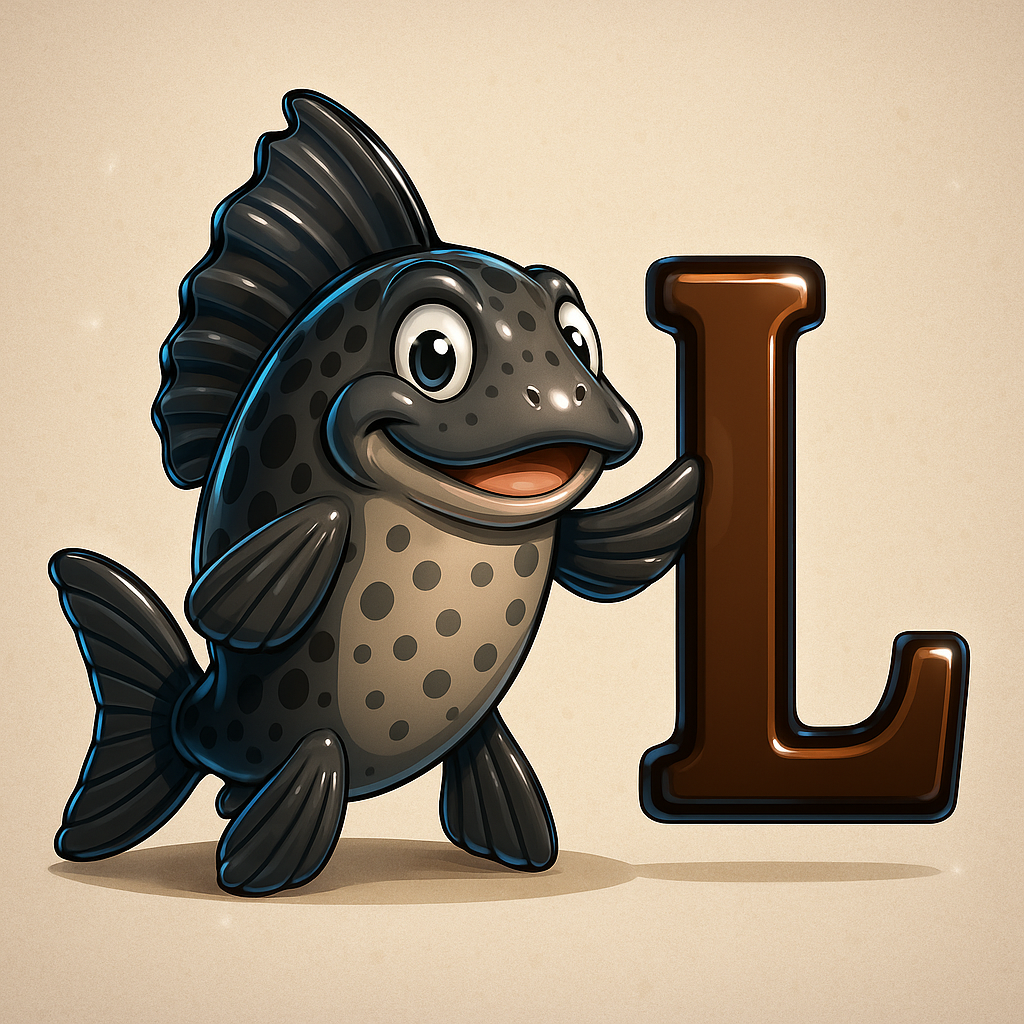Understanding the L, LDA, C & CW Numbering Systems
🧭 The Identification Codes Behind Plecos and Corydoras in the Aquarium Hobby
Fish importers, collectors, and aquarists often encounter strange codes like L333, LDA33, or CW009 on livestock lists and fish bags.
These aren’t random numbers — they’re temporary identification systems that help track new or undescribed species before they receive scientific names.
🐡 L-Number System (Loricariidae – Plecos)
📖 Origin & Purpose
- The L-number system was first introduced by the German aquarium magazine DATZ (Die Aquarien- und Terrarienzeitschrift) in 1988.
- At the time, scientists were describing new Loricariidae (pleco) species slower than they were being discovered and exported.
- To prevent confusion in the trade, DATZ began assigning “L-numbers” (for Loricariidae) to visually distinct imports.
🔢 Format
- The code begins with “L” followed by a number — e.g., L046, L333, L177.
- Sometimes, letters such as a/b/c are appended to denote variants (e.g., L236a, L236b).
🧬 Scientific Insight
- Each L-number corresponds to a photographed and published specimen, usually accompanied by collection data (river system, exporter, etc.).
- The system helps maintain consistency in trade and research until taxonomy catches up.
🐠 Examples
- L333 – King Tiger Pleco (Hypancistrus seideli)
- L046 – Zebra Pleco (Hypancistrus zebra)
- L177 – Golden Nugget Pleco (Baryancistrus xanthellus)
⚠️ Important Notes
- Duplicate Numbers: In some cases, multiple L-numbers refer to the same species collected from different localities.
- Unofficial Numbers: The highest officially published number is L528. Numbers like L600 are unofficial and not recognized by DATZ.
- Described Species: Once an L-number fish is scientifically named, both identifiers remain used in the hobby (e.g., Hypancistrus zebra is still referred to as “L046”).
🌐 Reference Resource
🔗 PlanetCatfish.com – the most comprehensive and trusted reference for all recognized L and LDA numbers, complete with photos, collection data, and taxonomy updates.
🪸 LDA-Number System (Das Aquarium – Alternative Loricariid Catalog)
📖 Origin & Reason for Creation
- As exports of Loricariidae skyrocketed during the 1990s, another German magazine, Das Aquarium, began receiving photos of new plecos not yet covered by DATZ.
- To fill the gap, they introduced the LDA-number system (Loricariidae Das Aquarium) as an alternative cataloging method.
🔢 Format
- Uses LDA### (e.g., LDA01, LDA33, LDA105).
- Follows similar structure to L-numbers but independent of DATZ’s numbering order.
🐠 Examples
- LDA33 – Gold Nugget Pleco (Baryancistrus xanthellus)
- LDA67 – Sultan Pleco (Leproacanthicus joselimai)
- LDA105 – Snowball Pleco (Hypancistrus inspector)
⚠️ Key Details
- Overlap Exists: Some species received both L and LDA numbers (depending on which publication described them first).
- Less Common Today: The system saw limited adoption outside Europe, but remains historically significant for older species lists.
🌍 Tip for Collectors
If you see a pleco labeled with both L and LDA numbers, it’s the same fish referenced in different catalog systems.
🐟 C-Number System (Callichthyidae – Corydoras & Relatives)
📖 Origin & Purpose
- Created by DATZ in 1993, the C-number system was modeled after the L-number concept.
- It catalogs new or undescribed species of Corydoras, Brochis, and Aspidoras — collectively known as armored catfish (family Callichthyidae).
🔢 Format
- C### (e.g., C001, C065, C125).
- Occasionally, variations are added (e.g., C125a, C125b) to denote regional morphs.
🐠 Examples
- C065 – Corydoras duplicareus
- C120 – Corydoras sp. “Peru Green Stripe”
- C125 – Corydoras sp. “C125” (undescribed species)
⚠️ Key Points
- Stopped at Around C159: DATZ discontinued assigning new C-numbers after 2006, leaving many recent discoveries without identifiers.
- Transition to CW Numbers: This led to the modern Corydoras World (CW) system.
🪶 CW-Number System (CorydorasWorld.com – Modern Cory Catalog)
📖 Origin & Modernization
- With DATZ’s C-system ending, Ian Fuller, a respected Corydoras researcher, launched CorydorasWorld.com to continue tracking new species.
- Introduced the CW-number system (Corydoras World Number) — now the active and expanding global reference.
🔢 Format
- CW### (e.g., CW009, CW045, CW127).
🐠 Examples
- CW009 – Corydoras sp. “CW009” (related to C. sterbai)
- CW045 – Corydoras sp. “CW045” (distinct coloration pattern)
- CW127 – Corydoras sp. “CW127” (undescribed Venezuelan form)
🧠 Why CW Matters
- CW numbers are widely accepted by exporters, hobbyists, and scientists for identifying unclassified Corydoras species.
- The system is continuously updated with photographs, locality data, and cross-references to existing C numbers.
🌐 Reference Resource
🔗 CorydorasWorld.com — the official registry for CW numbers, curated by Ian Fuller.
📊 Comprehensive Comparison Chart
| 🆔 System | 🐟 Applies To | 🧾 Introduced By | 🧩 Format | 💡 Example | 📆 Status | 🌎 Notes |
|---|---|---|---|---|---|---|
| L | Plecos (Loricariidae) | DATZ (Germany, 1988) | L### | L333 – King Tiger Pleco (Hypancistrus seideli) | ✅ Active (officially up to L528) | Most recognized system; still in active reference. |
| LDA | Plecos (Loricariidae) | Das Aquarium (Germany, 1990s) | LDA### | LDA33 – Gold Nugget Pleco (Baryancistrus xanthellus) | ⚙️ Secondary / Historical | Alternative catalog; overlaps with L-numbers. |
| C | Corydoras, Brochis, Aspidoras (Callichthyidae) | DATZ (Germany, 1993) | C### | C065 – Corydoras duplicareus | ❌ Discontinued | Replaced by CW numbers. |
| CW | Corydoras, Brochis, Aspidoras | CorydorasWorld.com (Ian Fuller, UK) | CW### | CW009 – Corydoras sp. “CW009”* | ✅ Active / Ongoing | Modern, frequently updated system. |
🧭 Why These Systems Matter
- 🧬 Taxonomic Placeholder: Provides consistent IDs before formal scientific description.
- 📦 Trade Clarity: Prevents mix-ups in imports, exports, and breeding projects.
- 🧠 Educational Tool: Helps aquarists and researchers communicate clearly about species.
- 🌍 Historical Record: Documents when and where species first appeared in the aquarium hobby.
🧡 Final Thoughts
These numbering systems have become an essential language of the catfish world.
Even after scientific names are assigned, aquarists continue to use the L, LDA, C, and CW codes — a nod to the history and discovery journey of each species.
